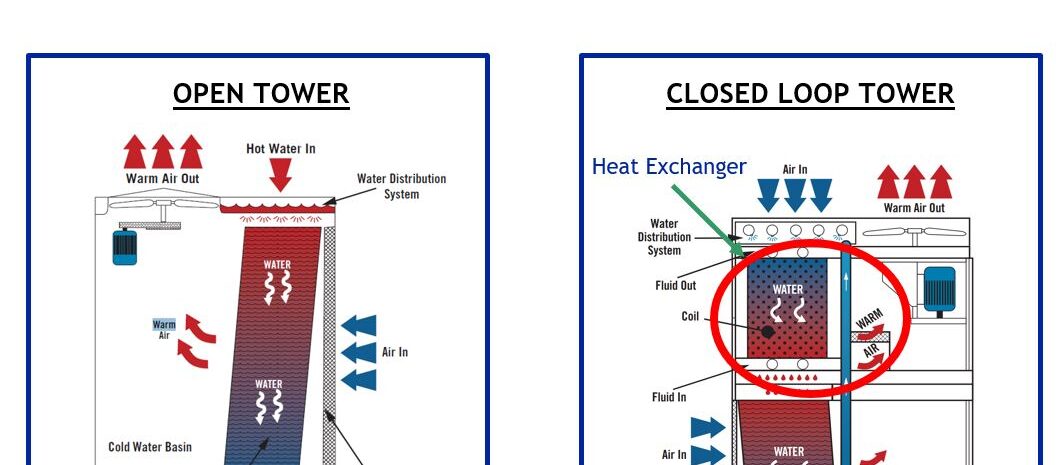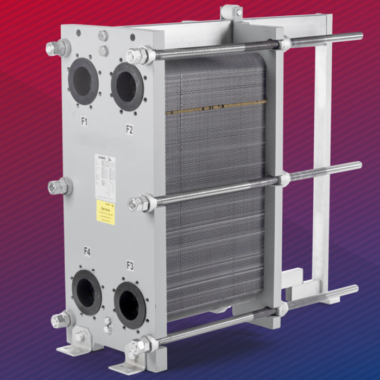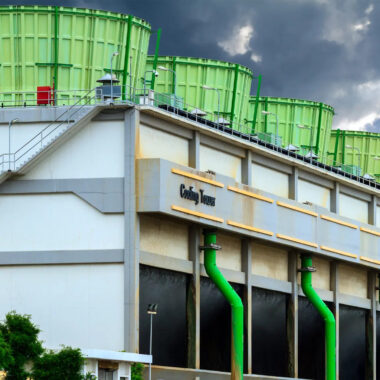Open vs Closed Cooling Towers
Introduction
Open vs Closed Cooling towers are essential components in industrial processes, HVAC systems, and power plants, helping to manage and dissipate excess heat. There are two primary types of cooling towers: open and closed systems. Each has distinct advantages and drawbacks, making them suitable for different applications. Open cooling towers rely on direct contact between water and air for cooling, which allows for efficient heat dissipation through evaporation. In contrast, closed cooling towers use a heat exchanger to prevent the working fluid from coming into direct contact with air, offering more control over water quality and minimizing contamination risks. This comparative analysis explores the differences in performance, efficiency, maintenance, and applications of open and closed cooling towers, helping businesses choose the right system for their specific needs.
Open Cooling Towers In an open cooling tower, water is exposed to air as it flows over the tower’s fill media, allowing a portion of the water to evaporate, which cools the remaining water. This type of cooling tower is commonly used in industries that require large volumes of cooling water, such as power plants and chemical processing facilities.
- Efficiency: Open cooling towers offer high cooling efficiency as the direct contact between air and water allows for maximum heat transfer through evaporation.
- Cost: These systems tend to have lower upfront costs and are simpler to install compared to closed systems.
- Maintenance: However, open cooling towers require more frequent maintenance due to the potential for scale buildup, water treatment needs, and microbial growth in the open water reservoir.
- Water Usage: They consume more water since some is lost through evaporation.
Closed Cooling Towers Closed cooling towers, on the other hand, keep the process fluid isolated from the air, flowing through a heat exchanger or coil. The fluid is cooled by air moving over the coil, often enhanced by water sprayed over the coil to improve heat exchange efficiency.
- Efficiency: These systems are slightly less efficient than open cooling towers because there is no direct evaporation from the process fluid itself.
- Cost: Closed cooling towers typically have higher initial costs due to their more complex design.
- Maintenance: Closed systems have the advantage of requiring less water treatment and reduced risk of contamination or scaling, making them more suitable for environments where water quality control is critical.
- Water Usage: Closed cooling towers conserve water better as the process fluid is enclosed, minimizing evaporation.
Applications and Considerations
Open Cooling Towers:
Open cooling towers are widely used in industries that require large amounts of cooling, particularly in power generation, chemical processing, and HVAC systems. Their primary application is in situations where water can be exposed to the air, allowing direct heat transfer through evaporation. Specific applications include:
- Power Plants: Open towers are used to cool steam condensers in thermal power plants. Their efficient heat dissipation makes them suitable for handling high volumes of heat generated in electricity production.
- Petrochemical and Chemical Processing: Open towers are commonly used in large-scale petrochemical and chemical plants to manage heat loads in cooling water systems for distillation and chemical reactions.
- Steel and Manufacturing: Cooling processes in steel production, where vast amounts of water are used to cool equipment and quench molten metals.
- HVAC Systems: In commercial buildings, open cooling towers are often paired with chillers to improve air conditioning efficiency.
Closed Cooling Towers:
Closed cooling towers are primarily used in applications that require a closed-loop system to prevent contamination and maintain water quality. They are ideal for environments where water conservation and efficiency are critical, and contamination needs to be avoided. Their key applications include:
- Data Centers: Due to the need for precise and reliable cooling, closed cooling towers are preferred to maintain optimal temperatures for servers and IT equipment without exposing the cooling medium to external contaminants.
- Pharmaceuticals: In the pharmaceutical industry, maintaining clean and pure water for cooling processes is essential, making closed cooling towers a preferred choice to avoid contamination.
- Food and Beverage Industry: Closed cooling towers ensure that the cooling medium does not come into contact with air, preventing the risk of bacterial contamination, which is crucial in food and beverage production.
- District Cooling: Used in district cooling systems where closed loops are required to reduce water evaporation and contamination risks while maintaining energy efficiency in densely populated areas.
Special Considerations:
- Mining and Heavy Industry: Both open and closed systems are used depending on the environmental conditions and cooling requirements. In arid regions where water conservation is critical, closed systems may be favored.
- Remote Locations: Closed systems are often used in remote installations where water supply and quality cannot be guaranteed, making water conservation and reduced contamination key factors.
Conclusion
The choice between open and closed cooling towers depends on factors like cooling requirements, water availability, environmental regulations, and maintenance considerations. Open towers are more efficient but require higher water consumption and maintenance, while closed systems offer lower water usage and cleaner operation but at higher upfront costs. Each has its merits, making the selection process dependent on the specific needs of the facility.






